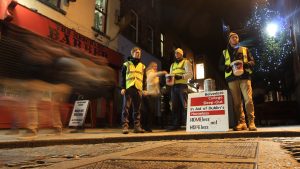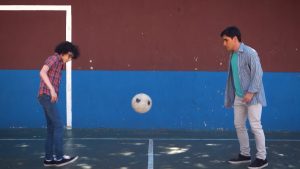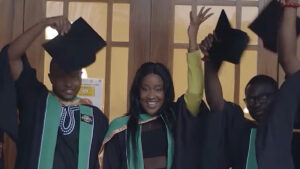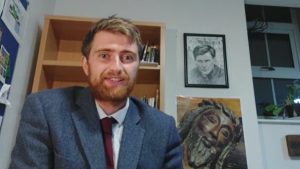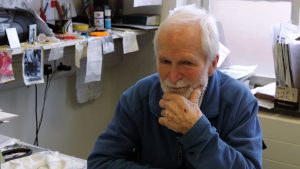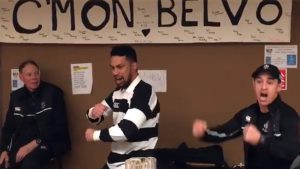“Just a lad of eighteen summers”
 Oliver Murphy, museum curator at Belvedere, takes a look at the life of Kevin Barry, a former Belvederean who was hanged on November 1, 1920, after his involvement in a raid on a British Army lorry which left three young British soldiers dead.
Oliver Murphy, museum curator at Belvedere, takes a look at the life of Kevin Barry, a former Belvederean who was hanged on November 1, 1920, after his involvement in a raid on a British Army lorry which left three young British soldiers dead.
Last Tuesday, November 1, was the 85th anniversary of the execution of Kevin Barry. Belvedere College marked the day by opening an exhibition to the public from 11.00 am until 4.00 pm. The exhibition reveals much about Kevin Barry – and raises questions about how he should be remembered.
Kevin Barry’s family were from Tombeagh, Hacketstown, in Carlow, near the Wicklow border, an area steeped in the folk memories of the United Irishmen and 1798. Kevin’s aunt Kathleen had established a dairy in Fleet Street, in Dublin’s city centre, and his family spent much of their time in Dublin, helping to run the dairy. Kevin was born at 8 Fleet Street in 1902. He had one older brother and five sisters. But Kevin attended the National School at Rathvilly in Carlow, while staying with relatives in the family house at Tombeagh.
When Kevin’s father (Tom) died in 1908, his mother (Mary) remained in Dublin. In 1914, Kevin attended St Mary’s College in Rathmines, but still spent his summers at Tombeagh. When St Mary’s closed in 1916 (it re-opened more than a decade later) Kevin’s mother had to find a new school for her younger son. Michael, the older son, went back to Carlow to work on the farm.
Mrs Barry obtained a prospectus from Belvedere College, which is located only a few hundred yards from where she lived. She decided that this was the place for Kevin, who was then 14 years old. It was perhaps a surprising choice for a family with such strong republican beliefs. Belvedere was a rugby-playing school; around two hundred of its past pupils were, at that time, serving with the British in the First World War.
But Kevin was at home in Belvedere. According to his biographer, Seán Cronin, “He did not try to hide his opinions from his teachers, nor did he proclaim them. Often ‘playful’, he was extremely serious behind it all.” In his first year at Belvedere, he played on the Junior Cup rugby team. They won the Junior Cup in 1917, with Kevin as first substitute. He even kept press cuttings of matches which involved Belvedere and stuck them in the Belvedere Prospectus which his mother had obtained.
Kevin’s true feelings can be seen by a close examination of his schoolbooks and copies in the exhibition. In his Mathematics copy, filled with quadratics and algebraic factors (not all of them correct!), we find the words of the rebel song: ‘Wrap the Green Flag round me, Boys.’ Kevin’s science notebook is signed, ‘Kevin G. Barry I.R.A.’ (and inside, at the back, there is a doodle of a rifle – drawn in quite good detail). He experiments with different spelling of his name in Irish: ‘Caomhín de Bárrá’ (spelt with two fadas) in one book and ‘Caoimhghein de Barra’ in another. In his book of Irish Prayers, he writes ‘Hoch der Kaiser’ [Up the Kaiser], showing that he was not at one with those former pupils of his school who were serving with the British at that time. But his scrapbook contains many unflattering cartoons of the Kaiser, whom he refers to as ‘Bill’.
Kevin joined the Irish Volunteers at the age of 15, while he was still at school. He was often seen cycling around Dublin, after his homework or a rugby practice, delivering messages to fellow Volunteers.
The 1916 Rising had brought changes to Belvedere. Two past pupils had died in the conflict: Reginald Clery (a member of the Volunteer Corps) was shot by rebels at Northumberland Road and Joseph Plunkett (one of the seven signatories of the Proclamation) was executed for his role as a leader of the Rising. Hurling was now introduced to the school. Kevin Barry played with Belvedere’s first hurling team – alongside Eugene Davy, who later won 34 international rugby caps. They appear in a photo of the 1917 hurling team. It is sad to note that while Kevin Barry was executed in 1920, Eugene Davy lived until 1996. Kevin (like many Belvedere boys) kept a ‘trophy’ of the Rising: a bullet, which he probably found in the rubble of Sackville Street near his home. It can be seen at the exhibition.
Kevin did well at school. In ‘Senior 1’, his class of 1918, he came fourth in a class of nine. But he was not always a model student. His science teacher, the Jesuit scholastic, Tom Counihan SJ, frequently wrote ‘No diagram’, when he corrected Kevin’s work. On one occasion, Kevin (attempting to solve a problem) wrote in his science copy:
Kevin’s final year at Belvedere went well. He played rugby with the Senior XV and passed his Matriculation with honours – for which he won a scholarship to study medicine at University College, Dublin. He was joined by Gerry McAleer, one of his best friends from Belvedere.
Kevin Barry’s biology notes, which he took while in ‘First Med’, reveal an earnest student. But Kevin failed his end-of-year exams. His commitment to ‘the cause’ and his social life got in the way of his studies. Kevin was a good-looking young student with an eye for the girls. A dance card of his, which can be seen in the exhibition, shows that he danced with a certain ‘Gertie’ five times. It would be interesting to find out who Gertie was. In a letter to Gerry McAleer from Mountjoy Prison, he wishes his friends ‘all the best in everything – even love.’ Like many a university student (before and since) he like to drink beer. In one letter, he describes how he fell off his bike four times on his way home to Tombeagh after a day’s drinking in Glendalough.
Kevin Barry was to sit his repeat exam on the afternoon of 20 September 1920. But that was the day on which he was to take part in a planned raid on a British Army lorry in Dublin. He decided that he could participate in the raid in the morning and then sit the exam in the afternoon.
On the morning of 20 September 1920, a British Army lorry went to Monk’s Bakery in Church Street, Dublin to collect bread for the army. It was ambushed. Private Harold Washington was killed at the scene. Two other soldiers, Private Tom Humphries and Private Marshall Whitehead, were mortally wounded. Kevin Barry was arrested at the scene when a woman warned the soldiers to mind the young man under the wheels of the lorry – where he was hiding as he tried to fix his gun which had jammed. He was thrown into the back of the lorry alongside the dead soldier.
The trial of Kevin Barry was of dubious legality. He was conscripted into the British Army and then court-martialled. The trial was brief. Kevin was sentenced to death and imprisoned in Mountjoy. Most people – including the Jesuits at Belvedere – expected that the sentence would be commuted, especially as Kevin Barry was such a young man. Kevin himself also did not really expect to die. In a letter to Gerry McAleer on the 30 September, 1920, he wrote: ‘Tell Mrs Tipping [the land-lady of their digs] that I will settle up with her when I get out – if I do.’
On Thursday 28 October, Kevin Barry was told that he would be hanged on the following Monday – the first of November. He could have got off. A warder at Mountjoy told the story that Kevin Barry was brought into the hang-house and shown the rope. At the same time, he was told that if he gave the names of his accomplices, he would be released, paid an annual stipend and allowed to study medicine at any university. In reply all Kevin Barry said was, “Yes, I think this will be able to take my weight, all right.”
Kevin Barry was remarkably calm and philosophical in the face of death, saying, “What is my life compared to the cause?” On the Saturday before his death, he wrote to Gerry McAleer, ‘When the first Meds are assembled, tell ’em boys and girls that I wish them all the best … and ask them to say a prayer for me when I go over the top on Monday.’ In a letter to a friend Kathy on the night before he died, he describes the Halloween treats of grapes and apples, which he had been served, ‘but I missed the nuts.’ He goes on to ask for her prayers ‘when I cash in.’
That weekend, Fr Frank Browne SJ, a teacher at Belvedere, cycled from the College to the Viceregal Lodge in the Phoenix Park (now Áras an Uactharáin). Fr Browne is now famous for his photographs – especially those which he took of the Titanic. Now, Fr Browne had been a chaplain in the First World War and had served under Lord French in Belgium. On the evening of Halloween, he went to ask Lord French, who was now the Viceroy of Ireland, to commute the sentence on Kevin Barry. But Lord French turned him down.
The following morning, a crowd gathered outside Mountjoy Jail. A bell rang out to signify that 18 year-old Kevin Barry had been executed.
Remembering Kevin Barry raises questions. When one of my first years saw ‘Kevin G. Barry I.R.A.’ written on the Science Notebook, he asked me, “Was Kevin Barry in the good IRA or the bad IRA?” I answered that it was up to him to decide that.
My own belief is this: We live in a free country. We have a democracy and independence. We have free speech. These were, surely, worth fighting for. I admire Kevin Barry and others who were willing to give their lives for us to enjoy our freedom. It seems churlish not to acknowledge the debt we owe them. Sometimes we forget how precious freedom is. Fewer than 50% of voters have voted in some elections here. Remembering Kevin Barry should help us to appreciate the things he fought for and sacrificed his life for – and to cherish them.
Furthermore, another point struck me as I was listening to discussions about the Morris Tribunal on the radio. Kevin Barry gave his life so that Ireland might be free and independent. Those who undermine the democracy, which he died for, are letting Kevin Barry (and others) down. To undermine our precious democracy is to undervalue the sacrifice that Kevin Barry and his like made.
However, the death of the three soldiers in the raid is both sad and regrettable. Private Harold Washington was only fifteen years old. He must have lied about his age to get into the army – but such was the shortage of soldiers after First World War that a blind eye was often turned to this practice. Private Marshall Whitehead was 20 – the only son of his widowed mother; Private Tom Humphries was only 19 – his mother, too, was a widow. (It has been said that one of the reasons why Kevin Barry’s sentence was not commuted was the young age of the three soldiers who died.) No matter how one looks at history, no matter what one’s politics, no matter what one’s religious beliefs, everyone knows that the loss of a child is tragic. The mothers of these three soldiers did not bring their sons into the world for this. Nor, of course, did Mrs. Barry – another widow – and she was not even allowed to bury her son. He was buried within the walls of Mountjoy Jail. There his bones rested until 2001 when they were re-interred in Glasnevin Cemetery after a state funeral.
The main question is this: does a just cause justify killing others? Some might say that the three soldiers who died were part of an occupying force who had no right to be here – especially when Britain had promised Ireland Home Rule in 1913. Indeed, many of those Irishmen who joined the British Army (including 200 former pupils of Belvedere) believed that by helping Britain to win the war, they were hastening the day of Ireland’s independence. It was a betrayal of their service – and of the ultimate sacrifice that so many of them made (including 47 former pupils and two teachers of Belvedere College) – to deny Ireland its promised Home Rule when the war was over. Indeed, if Ireland had been given its independence more promptly, neither Kevin Barry nor the three soldiers would have died so young.
The other question, which is linked to the last, is this: if we salute Kevin Barry for his actions, are we condoning those who have killed others in the north of Ireland over the last thirty-five years? If Kevin Barry was justified in killing three soldiers in Dublin, what of those who killed eighteen soldiers at Warrenpoint in 1979? Although this is a difficult question, it should be stated that, however regrettable the border may be to some, it is a fact of life. The majority of those in the six counties favour the status quo. Killing soldiers and policemen who represent the majority’s will is, surely, unjustifiable. (Indeed, there are many who would maintain that all killings are unjustifiable.) Kevin Barry and his comrades were fighting to uphold that which was legitimately theirs – and was promised to them – and they were willing to die for it. Those who bombed eighteen soldiers at Warrenpoint were not.
At its recent Árd Fheis, Fianna Fáil announced that it is going to commemorate the 1916 Rising next year with a military parade outside the GPO. They are trying to prove that they ‘own’ the 1916 Rising more than Sinn Féin. But what of Kevin Barry? A week ago, a nephew of Kevin Barry, whose name is also Kevin Barry, said to me that because his uncle died before the Civil War, “he belongs to nobody – and to everybody.”
The first duty of history teachers is to tell it as it was. That is why the exhibition at Belvedere shows details of the three soldiers who died as well as all the memorabilia of Kevin Barry. The second duty is to raise questions, both political and moral. By challenging young people to reflect on the past, we help them to make sound judgments on the historical events of today: for example, was the invasion of Iraq justified? Studying the past throws light on the present – and the future. That is why the great Greek historian Thucydides said that his own work was not written just to please the readers of his time, but was ‘a possession for ever’.


